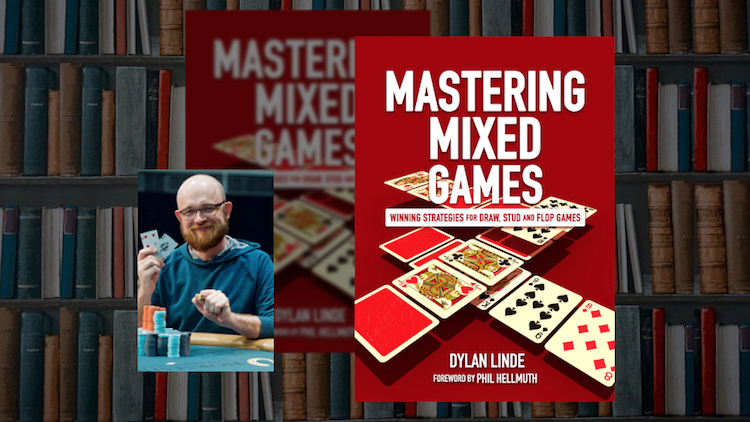Dylan Linde’s book Mastering Mixed Games: Winning Strategies for Draw, Stud and Flop Games was published during this summer’s World Series of Poker, and it has already been widely acclaimed by players seeking to improve their skills in games other than no-limit hold’em.
Linde’s book provides a thorough introduction to many different games, including fixed-limit hold’em, Omaha hi-lo 8 or better, no-limit 2-7 lowball draw, razz, seven-card stud hi-lo 8 or better, among other variants — that is to say, all the games that feature prominently in “mixed game” formats like dealer’s choice, H.O.R.S.E., and the 8-game mix.
After introducing you to each game, Linde explains basic strategy before moving on to advanced concepts, providing solid strategies for the different stages of hands while explaining how to apply generic concepts to each individual game and how to recognize and exploit game flow. There are numerous quizzes incorporated along the way to help readers reinforce ideas and concepts.
Linde has accumulated more than $4.1 million in live tournament winnings. He’s additionally won more than $6 million in tournaments online (according to PocketFives), the majority of which coming on PokerStars where Linde plays as “ImaLucSac.” He’s also a mixed-game regular (both live and online), having gathered a wealth of experience to go along with those earnings.
Here’s an excerpt from Linde’s discussion of “steal hands” in seven-card stud hi-lo 8 or better that provides a good example of the concrete, useful advice he delivers throughout the book.
from Stud 8-or-Better, “Steal Hands”:
[In Stud 8-or-Better,] Razz hands such as (3-4)-8 and (2-3)-7 can only make a mediocre low and have very little high potential. They should be played in a steal spot, but you should not call a complete with them. Steal spots are situations in which you may have the only low card up or when it folds around to you and you are a position or two away from the bring-in.
Jacks, 10s and 9s are very vulnerable and will almost never make a strong high hand. You should steal with them but otherwise they are terrible.
Connected high cards, such as (Q-J)-K, can be played in a steal position but otherwise are unplayable.
Next, we need to consider the manner in which these various holdings should be played. In Stud 8 the low card will often be able to defend their bring-in as three low cards is generally a decent hand. This may seem obvious but it changes the game dynamic.
Firstly, because low cards are often good the bring-in will be able to defend more often. This means that fewer steals will be successful and more multi-way pots will occur. However, there is also a bigger issue. Low door-cards do not reveal anything about a player’s hand. A player with a 2 up-card can have three 2s, aces, kings or three low connected cards. This means that hands with low door-cards basically have uncapped ranges. Players with them can choose how to play based on their holding, the players in the hand, and the result (in terms of number of players in the pot) they want to achieve.
This is not possible in a game like Limit Hold’em where any non-standard action reveals a lot about your hand. For example, if someone raises and you have aces you are always going to three-bet and never just call. Therefore, if for some reason you just call, you have capped your range to (at least) not include aces. Furthermore, equities run quite close in Stud 8 so there are many different plausible lines for every hand. Thus, with fewer steadfast rules you can interpret each situation on its own individual merit.
Conversely, you should play your high hands (where there is a high card as your door-card) aggressively, straightforwardly and in an exploitative manner. This is because from the outset your hand is somewhat face-up. If you play a king you can only have three or four different hands. You can have kings, three kings, aces, a buried pair, or three suited cards. Furthermore, your board will reveal what type of a hand you have, so you will not be able to deceive your opponents.
You cannot simply make a list of which hands you should play fast and which hands you should slowplay. If your opponents are observant then you should try to take the same lines with different types of hands. For example, don’t only two-bet aces but then call with (3-4)-A. This will give away too much information about your hand. Here is an example of A-A versus 7-6 in Hold’em compared to some Stud 8 equities. Notice how equities run so much closer in Stud 8.


This means there is far less incentive to push equity early on. Furthermore, your action on third street ripples across the entire hand. If you two-bet, then on fourth street, barring a perfect card, no one is going to fold as the pot odds will be too great. Additionally, they will be correct to call as there are now more bets in the pot and the direct odds to continue will be that much greater. This will again make the pot bigger on fifth street so, again, they will be more correct to chase. This creates less incentive to put in extra money on third street, with slight equity advantage, as opponents’ mistakes later in the hand become less magnified when the pot is bloated early on.
Mastering Mixed Games: Winning Strategies for Draw, Stud and Flop Games is available in paperback, as an e-book, and as an audio book at D&B Poker.
D&B Publishing (using the imprint D&B Poker) was created by Dan Addelman and Byron Jacobs 15 years ago. Since then it has become one of the leading publishers of poker books with titles by Phil Hellmuth, Jonathan Little, Mike Sexton, Chris Moorman, Dr. Patricia Cardner, Lance Bradley, Greg Raymer, Martin Harris and more, all of which are available at D&B Poker.
Back to Top







